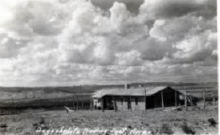Article
Burnt Water, or Tó Díílidí in Navajo, is a sparsely populated area in Apache County, Arizona. This county has the most land designated to Native Reservations in the U.S. and includes the Navajo Nation Reservation, the Fort Apache Reservation, and the Zuni Reservation. A specific kind of Navajo woven rug has also been named after this place, which features bordered, geometric designs in pastel colors.
There was a trading post in this location until 1983. A trading post is an establishment where goods can be traded. It is also a social center where news and gossip are exchanged. Trading posts have been associated with American frontier culture since the seventeenth century. Over time, trading posts developed into a cultural institution at first funded and backed by empire, later by national interests, and most often by enterprising business men.
"Begashebito Trading Post, 1923," photograph, New Mexico Centennial Project ( 1993_27_8). Farmington Museum.
Manuscripts
References
Linford, Laurance D.
2001 Tony Hillerman's Navajoland: Hideouts, Haunts, and Havens in the Joe Leaphorn
and Jim Chee Mysteries. Salt Lake City: University of Utah Press.
Sublete, Mark
N.d Burnwater Navajo Rugs. Medicine Man Gallery.
http://www.medicinemangallery.com/NativeAmericanIndians/Rugs/Burntwater,
accessed February 16, 2015.
Thybony, Scott
1997 Burnwater. Tucson: University of Arizona Press.
Turner, Frederick Jackson
1977 The Character and Influence of the Indian Trade in Wisconsin: A Study of the Trading
Post as an Institution. Norman: University of Oklahoma Press.

